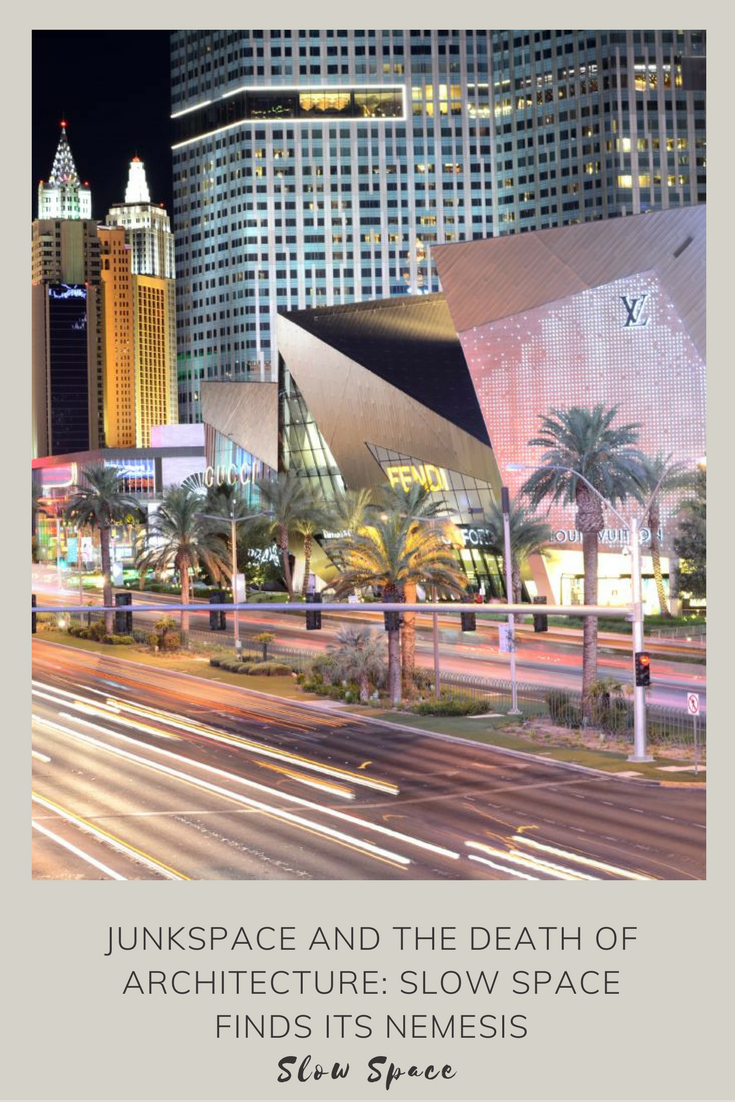“Junkspace” is a rambling, brilliant lamentation on the death of architecture by one who actively participated in its demise. It was a scathing critique at the time it was first published, but now 16 years later, it can only be seen as a prophecy. A siren call fully actualized.
The essay “Junkspace” by Rem Koolhaas first appeared in The Harvard Design School Guide to Shopping (2001). It was reissued along with an introduction and essay entitled “Running Room” by Hal Foster in 2013.
Surprisingly little has been written about “Junkspace” and I believe that is a reflection on the discipline of architecture rather than on the importance of the essay.
Koolhaas was far ahead of his time when he wrote this in 2001. What should have been a wake up call has merely languished. I myself was at the GSD then and had no awareness of what Koolhaas was doing or thinking. Nor can I recognize any shift in OMA’s work that might be attributed to this.
I stumbled upon the essay last year when I was doing my own research. The title alone spoke to me and I found the concept of Junkspace to be the perfect villain and counterpoint for Slow Space. The essay by Koolhaas should be read in it entirety as it can be interpreted in many different ways. Below is a series of excerpts from the text alternated with my own comments.
The End of Architecture
“It was a mistake to invent modern architecture for the 20th century. Architecture disappeared in the 20th century.”
Why? Because we lost our ability to appreciate, experience and therefore design space.
“As if space itself is invisible, all theory for the production of space is based on an obsessive preoccupation with its opposite: substance and objects, i.e., architecture. Architects could never explain space; Junkspace is our punishment for their mystifications.”
It is the resultant of the image-driven obsession with form.
“Junkspace is the body double of space, a territory of impaired vision, limited expectation, reduced earnestness.”
The junk food of architecture, Junkspace is the McMansions, the shopping malls and casinos that are bloated on fillers and chemicals.
“Because it cannot be grasped, Junkspace cannot be remembered. It is flamboyant yet unmemorable.”
Initially exciting but quickly leaves you feeling empty, lost and detached.
“Junkspace is overripe and undernourishing at the same time.”
And will ultimately make you sick.
Starchitecture
“Junkspace is post-existential; it makes you uncertain where you are, obscures where you go, undoes where you were.”
We are distracted from the essential questions of life – who are you? what is the meaning of life? – by busyness, overstimulation, visual and audible noise.
“(Note to architects: you thought that you could ignore Junkspace, visit it surreptitiously, treat it with condescending contempt or enjoy it vicariously… because you could not understand it, you’ve thrown away the keys…. But now your own architecture is infected, has become equally smooth, all-inclusive, continuous, warped, busy, atrium-ridden….) JunkSignature™ is the new architecture: the former megalomania of a profession contracted to manageable size.”
Junkspace is the dominant paradigm and architects, without protest or criticality, have succumbed.
“A shortage of masters has not stopped a proliferation of masterpieces. ‘Masterpiece’ has become a definitive sanction, a semantic space that saves the object from criticism, leaves its qualities unproven, its performance untested, its motives unquestioned. Masterpiece is no longer an inexplicable fluke, a roll of the dice, but a consistent typology: its mission to intimidate, most of its exterior surfaces bent, huge percentages of its square footage dysfunctional, its centrifugal components barely held together by the pull of the atrium.”
The avant-garde and cutting edge have become so commonplace. Every day a new iconic building replaces the last in the world lexicon of #architectureporn. Novelty feeds consumption and wastes our resources.
“Junkspace is a look-no-hands world….”
Stunts. Gimmicks. Turning Tricks.
Neoliberalism, Consumption and Entertainment
“Junkspace happens spontaneously through natural corporate exuberance – the unfettered play of the market – or is generated through the combined actions of temporary ‘czars’ with long records of three-dimensional philanthropy.”
Speculation and development provide the world with what people think they want and it becomes a self-fulfilling prophecy.
“Junkspace is political: it depends on the central removal of the critical faculty in the name of comfort and pleasure.”
Neoliberalism feeds Junkspace’s growth and power as it spreads across the globe.
“The chosen theater of megalomania – the dictatorial – is no longer politics, but entertainment. Through Junkspace, entertainment organizes hermetic regimes of ultimate exclusion and concentration: concentration gambling, concentration golf, concentration convention, concentration movie, concentration culture, concentration holiday.”
The King of Junkspace controls all of these kingdoms – casinos, golf courses, hotels and resorts – and has used entertainment as a means of wielding political force. In 2017, Koolhaas’s architectural lamentation has become a prophecy of the rise of Donald Trump.








I’m going to save this post for future reference for the next time that I feel enraged by everything I disdain about modern architecture and find sometimes difficult to explain! Thank you so much!
“Starchitecture” is a really great word:)